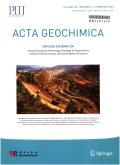Late-Silurian intraplate basalts from the southwestern margin of the Ordos Basin: Implication for decompression melting of metasomatized evolved mantle in extension setting
Abstract
The Longshan orogenic belt is located in the southwestern margin of Ordos Basin at the junction zone between the Western Qinling and Northern Qilian orogenic belt. Voluminous Early Paleozoic magmatism in this area is of key significance for determining the Early Paleozoic tectonic evolution and deep crust-mantle structure. Previous studies mainly focused on the Paleozoic granites; the coeval mafic rocks in this area are still poorly understood. A set of Late Silurian intraplate tholeiitic basalts has been discovered in Longshan area, providing key evidence for the mantle source and deep geodynamic background in this area. The Late Silurian Angou basalt has similar geochemical features as intraplate tholeiitic basalt, with high Na2O/K2O ratios (5.22–8.25), enriched in large ion lithophile elements and LREE. In combination with their relatively evolved Sr-Nd isotopic composition [87Sr/86Sr (i) = 0.7128–0.7140; εNd (t) = − 5.55 to − 3.40], it is suggested that it originated from decompression melting of metasomatized enriched mantle in extensional setting. These results indicate that the mantle source in the junction zone of the West Qinling-North Qilian orogenic belt evolved from depleted to enriched with the continuation of Proto-Tethys subduction from the Cambrian to the Silurian. These results are of great significance to understanding the genesis of contemporaneous granite and the crust-mantle interaction in the junction zone between the Western Qinling and Northern Qilian orogenic belt.


 求助内容:
求助内容: 应助结果提醒方式:
应助结果提醒方式:


